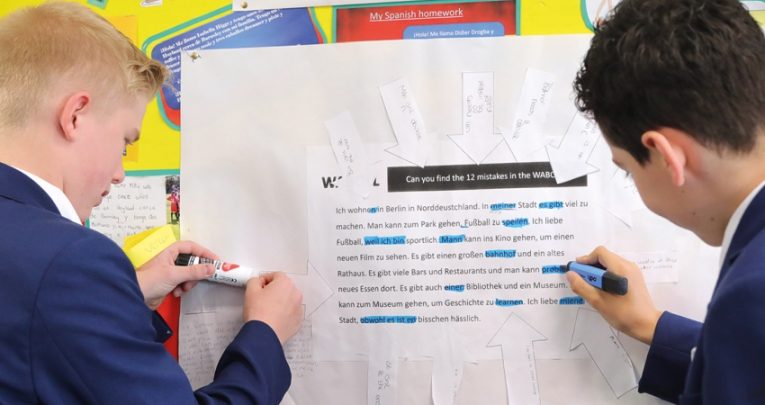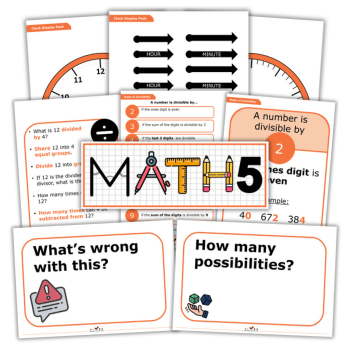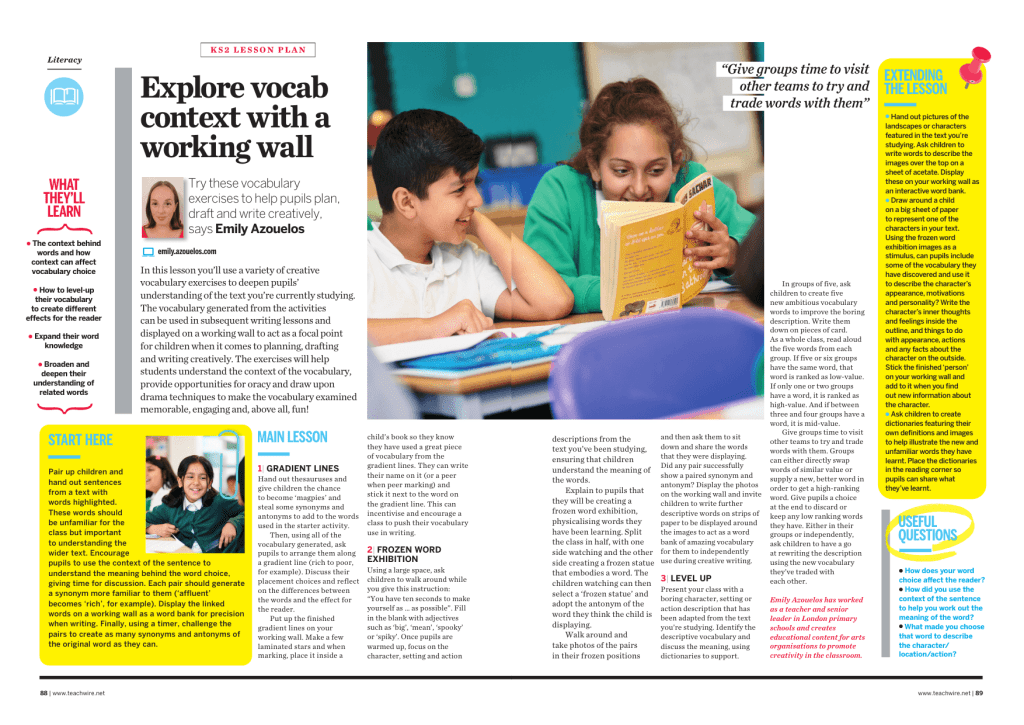Classroom displays – Advice, ideas & free teaching resources

Make your classroom walls work harder with these tips and pointers from fellow teachers…

- by Teachwire
- Classroom expertise and free resources for teachers

Stop seeing classroom displays as ornamental and start treating them as the powerful learning resource they are, with this round-up of advice and resources…
Why it pays to really work those walls
Claire Gadsby and Jan Evans reflect on how you can establish the expectation that pupils add extra ideas and reflective commentary to ‘finished’ work on your classroom walls…
Teachers invest a lot of time and energy producing attractive classroom displays of which they can be proud. However, we would like to ask the question – ‘If it is merely beautiful, why not just put up Laura Ashley wallpaper?’
Having worked in hundreds of schools over the years, we have come across many well-intentioned policies and guidelines for displays.
Indeed, we remember well the days of triple-mounting and neatly aligned staples. Whilst many of these policies aim to create attractive and stimulating environments, they are often concerned primarily with aesthetics, and with the outcomes of pupil and staff work.
“If it is merely beautiful, why not just put up Laura Ashley wallpaper?”
They also tend to assume that all pupils are automatically noting, understanding and retaining any information presented on the walls.
Perhaps this is hardly surprising when we consider some definitions of the word ‘display’ – ‘A collection of objects arranged for public viewing’ or ‘A show or event staged for public exhibition or entertainment.’
Even when you use it as a verb – ‘to put something in a prominent place so that it may readily be seen’ – the implied action is relatively finite. Once again the emphasis is on the product. As a result, we often use walls to house attractive, but static displays of finished work.
Whilst celebrating pupils’ achievements is undoubtedly important, this approach does little to support them and move their learning forward. So what needs to happen?
Repurposing
For all our well-intentioned policies and the effort we put into creating displays, you might argue that this is not having a significant enough impact on learning. Pupils are not routinely engaging with what is on their walls.
The novelty of even the most striking display soon fades to ‘wallpaper’ and does little to actively engage the pupils in thinking about the content. This is even the case if you occasionally refer to the display.
However, by consciously making thinking processes and pupil progress highly visible – through well-structured, purposeful and dynamic displays – these spaces can pay dividends.
Guidelines issued by nasen in relation to classroom displays and pupils with SEND recommend that teachers ensure their displays:
- Are informative, interactive and relevant
- Are uncluttered, so that pupils can easily find information
- Can be seen from every position in the classroom and be used regularly by all pupils as a point of reference
- Show a good use of colour, avoiding white backgrounds and black text
- Show keywords that are understood by all pupils
- Celebrate pupils’ work and make them feel valued
These guidelines contain well-thought-out, useful advice that would actually benefit all pupils, not just those with SEND – but it’s most important to note that word ‘interactive’.
“The novelty of even the most striking display soon fades to wallpaper”
The EEF’s Teaching and Learning Toolkit demonstrates that teaching metacognition can have a very positive effect on pupils’ outcomes. Pupils must be supported to engage with challenging concepts and articulate and own their learning. If used to stretch pupils and engage them in active responses, wall display space can become a vibrant, high-profile, public area for developing and refining higher-order thinking skills.
Reweighting
Wall space is limited, and therefore valuable, so ultimately it needs to cover those things that pupils find most difficult to understand and remember.
There is a value judgement to be made here. The display you have in mind, or have historically used may be beautiful. It may be celebratory. It may even make the pupils feel proud. All important points that have their place – but as the Pareto principle (named after the economist Vilfredo Pareto) reminds us, around 20% of the inputs lead to around 80% of the outputs with surprising frequency (Koch, 2017).
- Maximise pupil engagement first and foremost. The walls don’t just support the learning; they are the learning.
- Check that the time invested in setting up classroom displays actually pays dividends. Are you actively challenging pupils to think, respond, reflect and remember?
- Acknowledge that not all displays need to be polished and static. They can be interactive working resources to which pupils regularly contribute – or even generate and manage themselves.
- Ensure that learning comes off the wall and into the lesson before travelling back to the wall for later retrieval.
- Remember that even small changes to displays can have a dramatic effect.
In education, this broadly means that a relatively small number of vital concepts may hold significant value in terms of academic achievement. The challenge is to work out which concepts are the most essential in each subject, and so should be prioritised or front-loaded.
Impactful content, we believe, should have priority when it comes to display space. Also, size matters. Big messages need big writing – sometimes very big! Currently, many displays are essentially invisible to pupils due to the size of their lettering and positioning – often high up or at the back of the classroom.
Ask yourself – what is in the immediate eyeline of your pupils and what is on the peripheries? Is this weighted correctly? Are you doing enough with the space around the board, as this tends to be the focus of attention in most classrooms?
Re-energising existing displays
There are some easy techniques you can use to tweak your existing classroom display. These typically require a small amount of preparation, but will immediately increase the potential for active engagement and responses from your pupils:
Reframing
Rewrite success criteria as questions and display these prominently alongside the finished product. Beside a display of artwork, for example, you could ask, ‘Where can you see examples of perspective?’
This simple change immediately challenges the pupils to think and respond, leading to rich opportunities for discussion, clarification of misconceptions, and peer and self-assessment. If we are serious about facilitating the deep learning required in the National Curriculum, however, we must go even further.
For instance, after an appropriate period of familiarisation time, remove some prompt words from the display – perhaps replacing ‘perspective’ with ‘p ’. Now you’re calling on pupils to recall the word or concept.
Finally, remove all scaffolds, even the initial letter clue. What can pupils recall now?
Pick a prompt
Distribute paper or cardboard thought and speech bubbles to encourage the use of speculative language. Ask pupils to use them to record their ideas, and then position these in appropriate places around the classroom to jump-start thinking and discussion.
Some could have opening phrases like:
- Might
- Could it
- What if
- I think
- I wonder what
- This seems to suggest
Pupils can add their own contributions.
Laminating the bubbles will have the extra benefit of encouraging pupils to take risks with their thought processes. This is because they can easily amend what they’ve written after discussion and rethinking. (It also enables you to reuse them).
Revisit, resurrect and revive your classroom displays
We have to ensure that we use displays of exemplar work dynamically. Re-examine your existing exemplar displays by asking pupils questions such as:
- What were you learning about here?
- Are you still happy with this work?
- Could you tell me more about …?
- Is there anything you would change?
- How could you use this learning elsewhere?
The emphasis here is on extending thinking, not merely remembering or revising. Establish the expectation that pupils will add extra ideas, reflective commentary, etc. to any ‘finished’ work that’s on the walls.
- Complete words/phrases that have been partially covered up. Can pupils come up with an example of where it could be used?
- Spot which words/phrases have been removed from the display. What do they mean?
- Write a definition for one of the words/phrases. Other pupils can then critique this and give feedback with possible further suggestions before collaboratively devising the ‘best’ one.
- In pairs, devise a question that has a certain keyword as its answer. Use other pairs to check the accuracy, offer feedback and refine the question.
- Decide on the most important words/phrases for a specific topic. How do students justify their choices?
- Spot the odd one out.
- Discuss and identify connections and possible category headings. (Large, laminated coloured stars and arrows are useful for signposting the links. Plus they can be annotated with further explanations.)
Claire Gadsby is an internationally renowned author, consultant, trainer and keynote speaker with more than 25 years’ experience in education.
Jan Evans is an education consultant with over 40 years’ experience. She works with school leadership teams to develop strategic approaches to school improvement.
This article is based on an abridged extract from their book, Dynamically Different Classrooms: Create Spaces that Spark Learning, available now.
English working wall ideas

In this KS2 lesson plan you’ll use a variety of creative vocabulary exercises to strengthen students’ knowledge of your class text. Learn how to use the vocabulary that children come up on a working wall that will act as a focal point for planning, drafting and writing creatively.
7 time-saving display ideas for primary
Implement these ideas into your teaching early this term, and free up time the rest of the year, explains Julie Price Grimshaw…
1 First drafts
When pupils are working on a piece of writing that involves redrafting, display each draft – with marking if you like – and then the final piece.
It doesn’t matter how many drafts there are, and as long as each child is making progress, variability across the class isn’t really an issue.
The fantastic thing about this type of evolving display is that it makes children aware of the progress they are making, often over quite a short period of time.
When adults visit the classroom it’s great if children are able to talk through the process of improving their work.
2 Bigger picture
Get a large picture or poster, possibly related to a topic – but don’t let the pupils see the full picture. Cut it up into eight to 10 pieces – either try rectangles or more-complex shapes.
Start off by putting one piece on the wall and then invite pupils to put up the next pieces, one at a time.
You can stretch this over whatever time period you like and organise it so that that the pieces go up in a random order; the main thing is that it keeps the pupils guessing – they love this!
3 Place the punctuation
Make some commas, full stops, etc, from black card with a piece of sticky putty on each one. Write a sentence with no punctuation marks on a wall display and invite pupils to place the marks in the right place. This works best as an ongoing display with a new sentence each week.
4 Bags and buckets
Little gift bags are great. They can be used to create a fantastic display and it’s a really good way to recycle the ones you’ve been given.
Supermarkets and bargain stores sell some lovely gift bags, featuring attractive pictures and holographic designs, which can be stapled to a wall board.
You can fill them with all sorts of things – challenge work, puzzles, treats, rewards… whatever you like! A cheaper alternative is ‘buckets’ made from paper cups or similar, with scope here for personalisation.
5 Hanging postcards
Revive the art of postcard writing. Use postcards from different places or a specific location to fit in with a topic. To display, punch a hole and hang by string so that both the picture and written side are visible.
6 Charity scarves
Displays using fabric look fantastic but can also be time consuming. Charity shops often have cheap but beautiful scarves that you can adapt to all sorts of displays quickly and effectively. Tie or staple onto boards or hang from above.
7 Off the wall
Displays aren’t just for walls – get a basket or box and fill with small items (toys, books, messages, maps, key words) related to your topic. You could even link this ‘display’ to an activity, such as a treasure hunt.
Julie Price Grimshaw is a teacher, school development adviser and former HMI. Follow her on Twitter at @julespg.
Working walls – for and against
Why busy classroom walls distract students
Is it time to step away from the sugar paper, asks David Didau…
It is an unwritten rule of teaching that teachers should liberally plaster every wall in every classroom with brightly coloured display.
Typically, this will include examples of students’ work, helpful advice or information specific to the subject students are studying – grammar rules, key word spellings, foreign vocabulary, number facts etc – and what might best be described as ‘general decoration’.
The thinking seems to be that classrooms must provide a veritable sensory feast with no surface left uncovered. But is this just another educational fetish?
Trending
How much display is there mainly to gull visitors into thinking, oh what a jolly school this must be? Might some schools be using such colourful classroom displays to paper over other cracks?
Workload agreement
The effort involved in putting up, refreshing and replacing classroom displays requires an enormous investment in time. Is it fair to expect teachers to make such an commitment? Fortunately, this issue is enshrined in legislation.
The 2012 workload agreement clearly states that leaders can’t routinely require teachers to undertake any clerical tasks including, “Preparing, setting up and taking down classroom displays”.
I fully recognise that there will be school leaders who find wiggle room in the word “routinely”. Leaders still put some teachers under enormous pressure to create and refresh classroom displays, but hopefully this is becoming rarer.
“Leaders still put some teachers under enormous pressure to create and refresh classroom displays”
A waste of time
We should also consider the time it takes children to create work for the purpose of such displays; time and effort that they could, conceivably, spend on more profitable endeavours.
The assumption that displaying students’ work is automatically a ‘good thing’ leads teachers to devote curriculum time to making posters and other items of dubious educational merit.
As an aside, the average Year 7 student spends far more time than you might believe feasible making posters. I’ve got nothing against posters per se, but I seriously doubt whether, in most instances, they’re worth the time pupils spend on them.
One argument is that children can learn from seeing each other’s work, but blu-tacking up a bunch of essays on a wall is unlikely to be the best means of achieving this worthy aim. Visualisers are increasingly inexpensive and provide a far more effective way to share and discuss students’ work.
“Blu-tacking up a bunch of essays on a wall is unlikely to be the best means of achieving this worthy aim”
But perhaps there’s a motivational benefit to students seeing their work displayed? Maybe they’ll work harder if they think it will be on public view?
Well, although many children like to have their latest poem placed where everyone can see it, and some teachers enjoy teaching in busy environments, it might benefit everyone to think a little more deeply about exactly why we feel this to be such an important aspect of teaching.
How significant are the benefits, if indeed they exist at all?
Tear it down
Fortunately this is an empirical question. In 2014, Fisher, Godwin and Seltman investigated the effects of display on students’ behaviour and attainment.
They found learners were less likely to stay focused, and attained lower test scores, when they received experimental lessons in a ‘decorated classroom’, compared to a ‘sparse classroom.’
Further, test scores were negatively correlated with the amount of time that students were distracted, suggesting a direct relationship between these two variables.
The researchers conclude by saying, “colourful visual displays may promote off-task behaviour in young children, resulting in reduced learning opportunities and achievement”.
They do make the point that there was significantly less disruption after children got used to the displays in the second week. I’d suggest that’s the point at which the display has become meaningless wallpaper.
Isn’t the very intention of most display to capture students’ attention? What then is the point of a display that doesn’t distract them?
No one wants bare walls, but that doesn’t mean we have to distract students with endless garish exhibitions. Most people would readily agree that classroom display should support students’ learning. If it fails this uncontroversial test, then, shouldn’t we tear it down?
David Didau blogs at learningspy.co.uk and is the author of several books, including What If Everything you Know About Education Is Wrong?. You can follow him at @DavidDidau.
Why working walls don’t make classrooms exciting places to learn
The trouble with working walls is that they make every class look the same, says this anonymous teacher…
I first encountered working walls around 2015. My head at the time had heard about them being used in a local school. He decided ours should follow suit. He didn’t want to be left behind when it came to the latest fad.
Overnight, the headteacher deemed our displays inadequate. He began the staff meeting with the words, “I am disappointed with the displays in the classroom and don’t feel pupils are learning anything from them.”
As you can imagine, staff were bemused. All the classrooms looked amazing and stunning. We changed displays every half term, all six in every class, and each display was very personal to each teacher and group.
Overnight, without warning, our displays were useless. The head continued by taking us to see a classroom with working wall displays in place. The deputy’s class had been transformed (overnight?).
It was now a modelled classroom full of working walls. The deputy claimed that it had been helping the children make excellent progress. We knew the displays were new and this was another game-playing exercise.
Raw and edgy
By the end of the week, all of the classrooms had to adopt the new working wall model. They had to look raw and edgy, based on those the headteacher had shown us. That meant nothing mounted, everything handwritten, paper pinned up at funny angles and overlapping the borders. What the class had been working on needed to be instantly obvious to an observer.
Now the penny dropped; it was more to do with providing evidence than the actual learning. Of course, the head disagreed. It was a done deal, non-negotiable.
“It was more to do with providing evidence than the actual learning”
We had to have working walls for writing, maths, science, spelling and topic. We had to update them every lesson and take everything down and start again – anywhere between one to three weeks.
Most of the time, boards were half empty and looked messy. They were often out of date because the teachers couldn’t find time to refresh them.
But the head liked messy; it showed how current and trendy the working walls were. He claimed the children used them to aid their learning. We disagreed.
We argued that updating so many display boards added to our workload and, contrary to what he thought, pupils didn’t use the working walls to help them learn.
Telling staff what displays to create, what they needed to look like and how often to change them demotivated us. We enjoyed having complete autonomy over our classrooms. Now that was gone.
Proud wall
Most teachers I speak to don’t want senior leaders telling them how to use the display boards in their classrooms. Standing in the middle of an empty classroom and pondering how to transform it into an engaging and inspiring place is all part of the fun of being a teacher.
“Telling staff what displays to create, what they needed to look like and how often to change them demotivated us”
I recently put up a display called the ‘proud wall’; every child had a space to put up some work they had pride in. The pupils loved it. It had all sorts of work on it, including maths, writing, art, science and topic.
The headteacher told me that having pupils’ work on display doesn’t do anything to help them learn. He told me to take it down because it wasn’t a working wall. It had to be empty when the pupils walked in on the first day of term so I could put things up over the next few weeks.
Lost all interest
My spelling display was interactive, full of activities the children could do. But it wasn’t a working wall so I had to take it down.
The working wall had to have that week’s spelling on it and nothing else. It had to make the learning very clear to visitors. Ironically, the children lost all interest in the display. But at least I ticked a box.
In some years, I have asked the class to help choose what the boards should have on them. It is their classroom after all. But when was the last time we asked children what they would like on their displays?
If the teacher doesn’t own their classroom, they don’t fully invest in it. Imagine being a pupil going through primary school where the displays always look the same. Consistency isn’t always the answer.
The Fake Headteacher has taught in five schools across a 20 year career.
How to make displays useful for students
By making your classroom displays work harder, you can make retrieval practice considerably easier, says Adam Riches…
In 2014, Anna Fisher of Carnegie Mellon University’s department of psychology found that children were less likely to stay focused in highly decorated classrooms. Students who were taught in such environments received lower test scores than those taught in comparatively sparse spaces.
Displays need to be useful. They need to help the learning of pupils – but how?
Have focal points
This doesn’t simply mean plastering your walls with random words, hanging objects from the ceiling and making the room resemble a maze of paper.
Make your room a 360° experience, but group resources together – key terms in one place, writing frames in another and exemplars in another.
Refer to them often
Make pupils use resources that you point to in the course of your teaching and keep referring to them, as this makes them memorable.
Use your room to guide your kids through their exams by putting up key words/vocabulary, phrases, concepts, graphs, pictures or models of great work with annotations.
Change things up
Don’t restrict your displays to static resources, as this is a waste. Periodically take down resources when the time is right and use the resulting gaps to put up recall exercises.
Build in low stakes testing around your displays and replicate them where possible, so that students can use them at home. Little tricks like this are a great way of building engagement with resources that have taken you time to make.
Show model work
Displaying model work – such as a paragraph structure, for example – can save you lots of time and a great deal of frustration. Just imagine not having to repeat concepts that you’ve covered (sometimes many, many times) before!
Adam Riches (@teachmrriches) is a senior leader for teaching and learning










